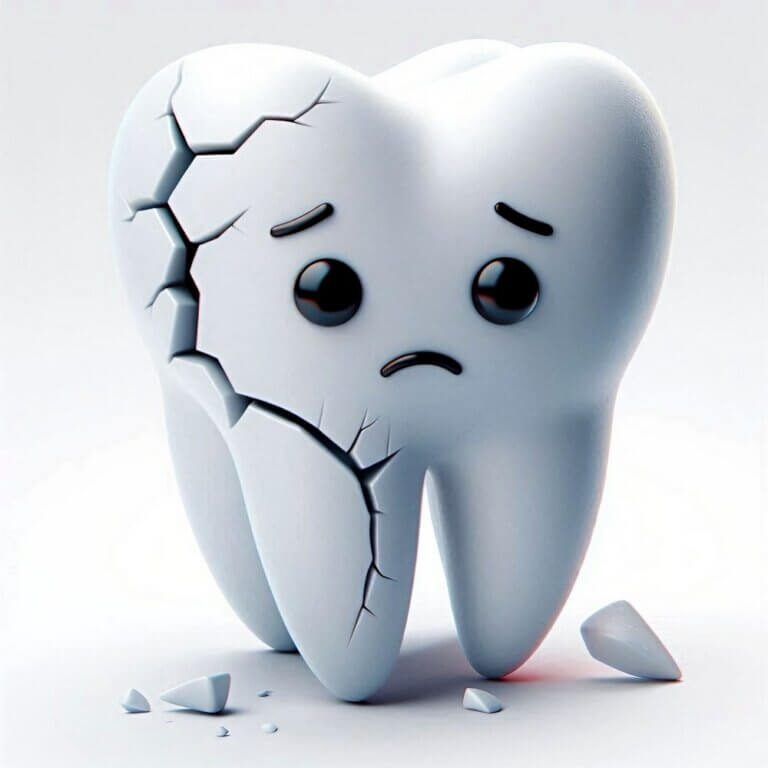Dental fractures can occur even under normal chewing forces, especially when teeth are weakened by decay, misalignment, or uneven load due to missing teeth.
Addressing these factors is crucial for maintaining dental health and longevity.
In this article, I will share insights into why teeth break and the importance of proactive treatments, like aligners, to safeguard your smile for a lifetime.
Why Our Teeth Break
My Tooth Broke!
That was what a passenger on a flight said when she bit into an ice cream sandwich.
According to news sources this week, the passenger was on a flight overseas last August. She claims that the ice cream was “frozen solid,” and she sustained an injury to her upper lateral incisor. The injury was so severe that extraction of the tooth was the only treatment, followed by the placement of a dental implant.
When I read this story, I began thinking about why some teeth fracture and others do not.
Of course, anything can be overpowered or overwhelmed by excessive force, but let’s assume for a moment that the force, whether from chewing or even a blow, is within normal limits.
Yet, despite the normalcy of the “blow,” the tooth breaks. Yet, there is no damage in another patient or a different tooth.
Most patients I see with broken teeth do not complain about frozen desserts or rocks in their food. They came to me to evaluate a tooth that had fractured under regular chewing forces. The cause of the break is often weakened tooth structure due to decay. A cavity grows inside a tooth, making it substantially weaker and susceptible to fracture.
Missing Teeth
I have written extensively on the need to replace missing teeth.
One primary reason is the resulting overload on the remainder of the teeth. With each tooth that is lost, the teeth that are still intact must bear the brunt of the forces of chewing.
Continual overload eventually weakens the tooth, resulting in a broken tooth. If the break is severe, the only treatment is removal, and the downward spiral will continue.
Misaligned Teeth
Another type of overload can occur even without missing teeth. When our teeth are not aligned properly, certain teeth bear the brunt of chewing. Constant wear from eating will weaken the tooth. Patients with misaligned teeth may often be tooth clenchers or grinders. Again, the teeth that hit the first must withstand these additional forces, which are the consequences of this harmful habit.
Like all things in life, when we are young, our teeth are robust and designed to last for decades.
We live longer than our parents and grandparents, and our teeth hang around longer than in most of history.
When I see a patient with crooked or misaligned teeth, I recommend moving them out of harm’s way and into a more healthful position.
The result usually improves cosmetics, but that is not my primary goal. I want your teeth to stay intact.
Invisalign® Aligners to the Rescue
In the past, the only way to predictably move teeth involved metal brackets and wires. You know these as dental braces. Today, there is another method that uses clear plastic devices called aligners. Every case differs, and the number of aligners needed to correct the problem can vary.
In our office, we only use name-brand aligners, and one of the best-known is Invisalign. Invisalign is my choice for tooth movement because it is rich in features and backed by years of use in the dental field. They informed me recently that they have reduced fees for the rest of the year, and I encourage you to take advantage of this great money-saver.
The next time you smile in front of a mirror or brush your teeth, look and see which tooth is a potential fracture problem due to excess chewing pressure.
Call me at 440.951.7856 and speak to Nikki or Jamie. They will set up an appointment for us to meet.
Jeffrey Gross, DDS, FAGD, is a highly qualified and experienced general dentist licensed in Ohio. He is also a respected Case Western Reserve School of Dental Medicine staff member.

